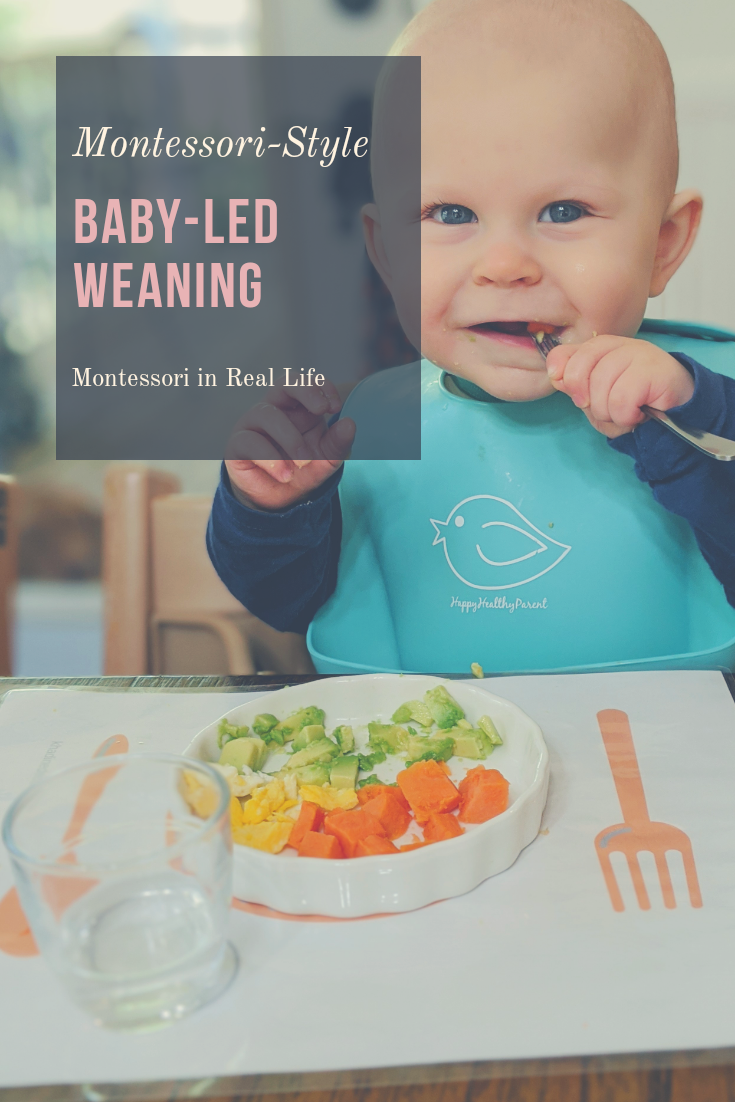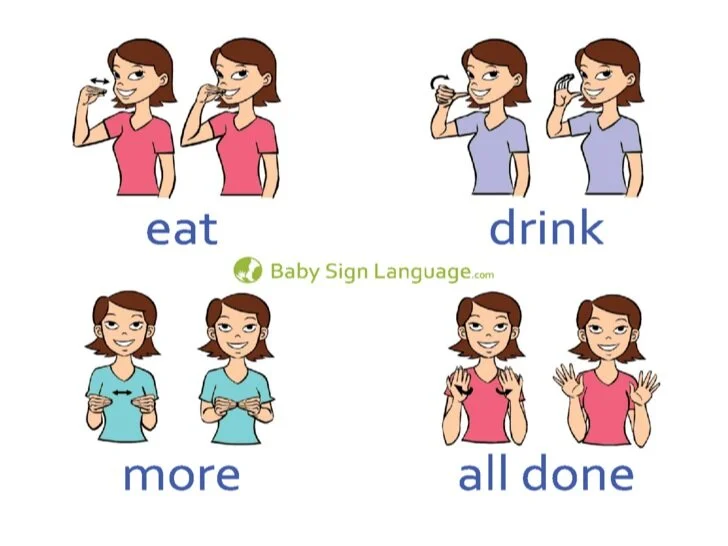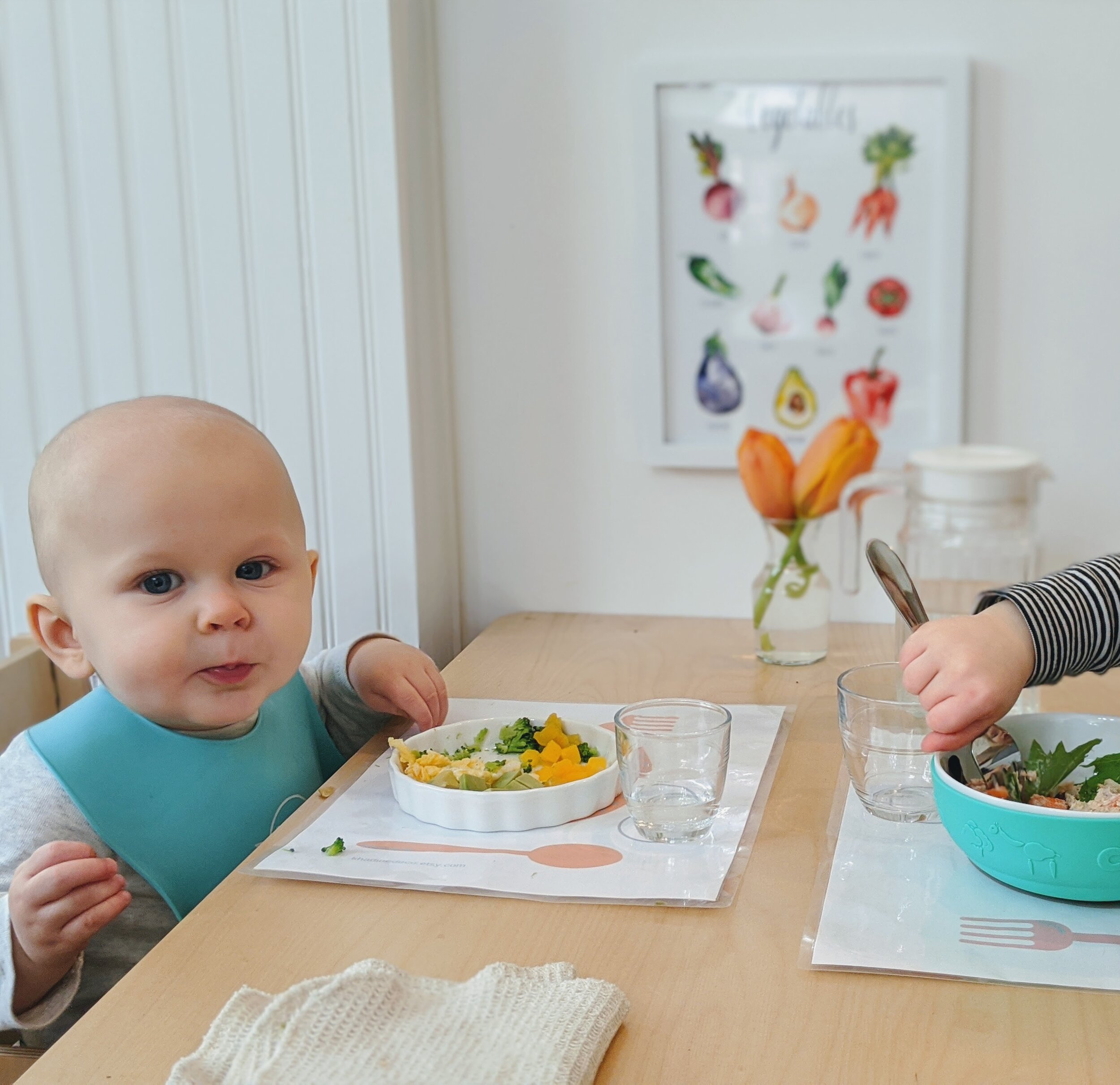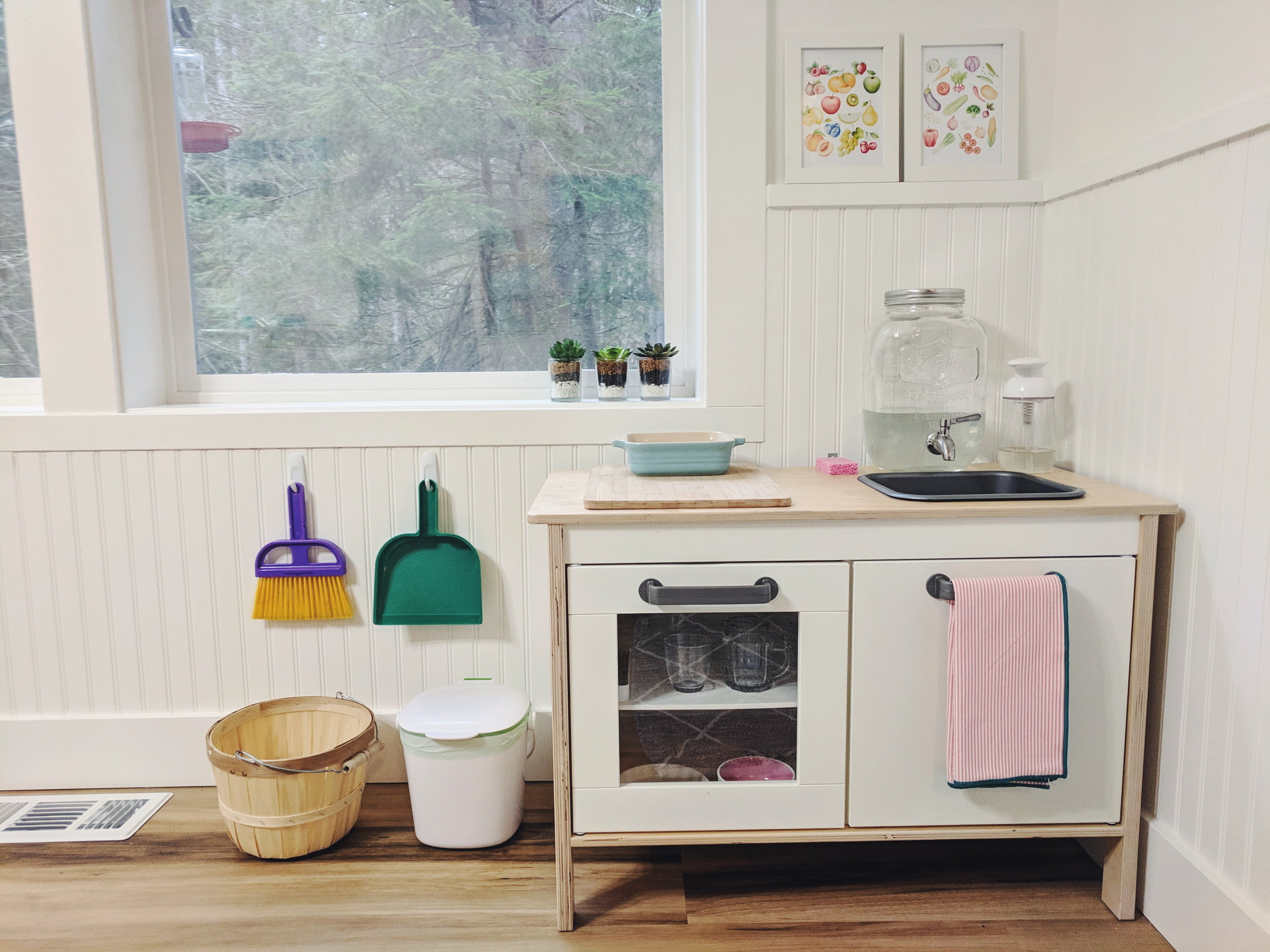Baby Led Weaning, Montessori Style
Montessori in Real Life
A key element in the introduction of solid foods in a Montessori home is respect. We show the infant respect by providing them with real dishes and utensils. Infants in turn learn to respect and care for their environment early on. It is one of the first opportunities for infants to practice autonomy and feel the pride and satisfaction that comes with our trust and respect.
Weaning vs. Family Table
One of the first ways we show infants respect is by setting up a lovely place for them to eat. In our home, we have a couple of options for this. We have two Stokke Trip Trapp chairs for the children which are wonderful because they grow with them. S is still in the baby set, but he can sit right at the family table with us. D has been climbing in and out of hers since 20 months or so. We all sit at the family table for breakfast and dinner, and sometimes lunch.
We also have a Sprout Kids weaning table for the kids to sit at. A low table is great for babies becuase it makes the dropping and throwing game less exciting (dishes have less far to fall). It also allows independence once they are more mobile. It is extra special for toddlers when they can begin to set their own table and clear their dishes. Both D and S love sitting together at their small table, and I just sit on the floor next to them. We typically do morning and afternoon snack, and sometimes lunch here. You can get 10% off the Sprout table with the code MRealLife.
Purees and BLW
When we started S on solids around 6 months, we began with purees. Once he got comfortable with that, we introduced small strips of food, and then bite-sized pieces around 8 or 9 months. Though we didn’t start with traditional baby-led weaning, S has been involved in feeding himself each step of the way. When we began purees, we each held a small espresso spoon. I would dip my small spoon in the bowl and feed him, but he could practice or just play with his spoon as well. Often he would take over and hold it once it was in his mouth. Now, I can load the spoon for him, set it down in his bowl and he feeds himself. He then places it back down for me to scoop again. Soon enough he’ll be dipping, scooping, and feeding himself. (Tip: start with a thick food such as mashed avocado or chia pudding that is sticky and easy to scoop.) Since eight months though, most of his meals are finger food, in baby-led weaning style. He finds a lot of satisfaction chewing and eating what his big sis is, even without teeth! Though we practice with the small fork in the same way, he eats a lot with his hands, which is great too! Infants and toddlers will use utensils when they are ready, if they are available to them.
Real Dishes
We love our small shallow ramekins as dishes because the food can pressed up against the edges rather than falling off the plate when they reach for it with their fingers or utensil. The small spoon and cocktail forks give them practice with the same kinds of utensils we use, while fitting nicely in their small hands. The cocktail fork has sharp tines, making it easier to actually pierce food with. (Supervision necessary.) We have avoided suction plates because they don’t teach infants how to be careful with their dishes. They also often become a game of trying to “unsuction” and toss.
Placemats
We place the children’s dishes on these wonderful, outlined placemats by Khadine Deco. While these aren’t necessary, they allow for infants to know dishes have a designated place on the table. The outlines are great for D because she can set the table by herself, knowing exactly where her utensils and cup go. We have cloth and laminated versions (the latter being easier to clean and re-use frequently!) You can use code reallife10 for 10% off either version.
Glasses
We also prefer to use open glass cups for drinking because they teach children how to properly drink from a cup and allow for natural consequences when the cup is dropped. We use small duralex cups at home because they are much tougher than typical glass, so while they spill, they are unlikely to break/shatter when dropped. The three-ounce version is perfect for S, and the 5 ounce glass is great for D. Clear glass is also preferred because infants and young children can see how much is in the cup before picking it up and drinking from it.
When we first introduced the cup (the same time he started solids), I held it for him as he learned how to sip from it. Once he got used to that, I would let him practice picking it up from the table. There were plenty of spills, but I always keep a small washcloth or napkin and pitcher to refill the water. I also only fill the water cup 1/4 the way full, so it’s not a flood every time. By 10 months he could bring the water cup to his mouth, drink, and set it back down. He doesn’t get it right every time, but he’s learning more every time he tries. If he is just playing or putting food in the water, it’s a sign he’s all done and we remove the cup. He isn’t going thirsty, as he’s still getting plenty of hydration and nourishment from nursing.
Supervision
As you might imagine, using real dishes means close supervision. It is especially necessary to sit with your infant as they eat, either on the ground at their weaning table, or beside them at the family table. It is much harder for them to dishes or food if you’re right there to catch them, and the best way to prevent them from getting in a throwing habit is to stop it before it happens. If S begins to drop food (e.g. to our dog) or push his dishes around a lot, I say “Food stays on the table”, and if it happens again, “It looks like you’re all done!” and sign “all done” with my hands. I then take away the dishes. It’s often a sign that they aren’t hungry or interested in the food if they are playing rather than eating.
Now that S is used to his dishes staying on the table, I am able to walk away and get my own food or do a few dishes while he finishes up eating. I am always close by though. At 10 months, he already shows respect for his environment, in large part because he has been shown respect and trust at mealtimes. Babies are capable of so much if we give them a chance. It also means practicing patience ourselves and embracing plenty of mess along the way!
Communication
A big piece of the weaning process has been clear communication. I talk to S as we get ready for eating, and label the different foods for him. I use baby sign as I talk for words like “eat”, “more”, “water”, and “all done”. He is starting to sign “more” and “all done” now. He also very clearly understands what I’m saying, as he reaches for the water as soon as I ask him if he wants water, with my voice and signing. Including babies in the conversation from the very beginning helps them feel empowered and in control at mealtimes, and beyond. By giving S the tools to communicate back via baby sign, he can tell us when he is still hungry or is all done. This can help to prevent throwing and other difficult habits that often come from an inability to communicate their wants and needs.
On the Go
One of the beauties of using real dishes and teaching respect early on is that it is much more pleasant to take your infant or toddler to eat at restaurants. D has always done remarkably well at restaurants, and (when we are allowed to go out of our house again!), I hope S is too. Often we’ll keep a bib as well as a baby spoon and fork in the diaper bag, but just use the plates and cups that they have there. When we take long walks or go out, we typically bring our favorite straw cups. These aren’t leak-proof so they do need to remain upright, but they can’t pull the straw out which is nice. I taught S how to use this around 10 months by sucking a little smoothie up for him, so he could taste it, and know that he has to suck to get more liquid up from the straw. You can also use squeezable take & toss straw cups to better assist your infant in learning how to drink from a straw (you squeeze the cup lightly and liquid goes up the straw for them to suck.)
The Montessori Kitchen Guide
For a complete and detailed guide to Montessori weaning, challenging behaviors at the table, involving your toddler in the kitchen, and more, check out our 60-page Montessori Kitchen Guide e-Book!
Note: This post contains affiliate links. If you purchase a product through one of these links, you won’t pay anything extra, but I will get a small commission, which helps keep this blog going. Thanks for supporting Montessori in Real Life!


















